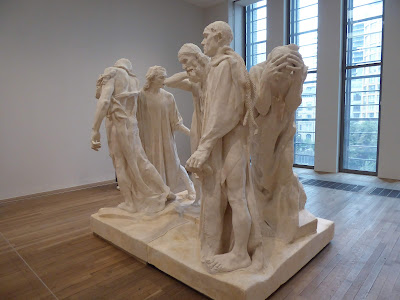In July I went to see this exhibition of 'The making of Rodin' at the Tate Modern. It wasn't a large exhibition and did not have many of Rodin's sculptures. Instead it showed how his sculptures materialised from his original ideas. Rodin worked principally by modelling in clay. It was only once he had achieved success that he could afford to have multiple plaster casts of his clay models. These allowed him to alter and revise his works many times.
The Burghers of Calais. In 1346-7, the French port of Calais was besieged by King Edward III of England. he agreed to spare the people of the town if six of their leaders surrendered to him with ropes around their necks, ready to be executed. Eustache de Saint-Pierre and five citizens volunteered for the task. They were ultimately spared. In 1885 Rodin was asked to create a monument to Eustache de Saint-Pierre. Rodin decided to depict the collective sacrifice of the group rather than one hero.
The burghers were first modelled unclothed. Fabric tunics were dipped in plaster and draped over the nude sculptures. This allowed the withered outline of the bodies to be seen clearly beneath the garments.
The Thinker was originally conceived as part of The Gates of Hell monumental bronze doors commissioned for a proposed Museum Decorative Arts in Paris. Rodin planned an assembly of 180 figures inspired by Dante's Inferno. Ultimately plans for the museum fell through and the gates were never completed. However it provided Rodin with a large number of figures that he could rework and repurpose. In 1888 Rodin developed the Thinker as an independent work originally modelled in clay and then cast in plaster. The result could then be copied, resized, and transposed to bronze or marble. This figure is coated plaster..
Study for The Thinker
Balzac. Final study for the head in plaster.
Rodin used drawing to study movement and the internal dynamics of the body. Rather than making his sitters strike a pose he would ask them to move freely around the studio.























































